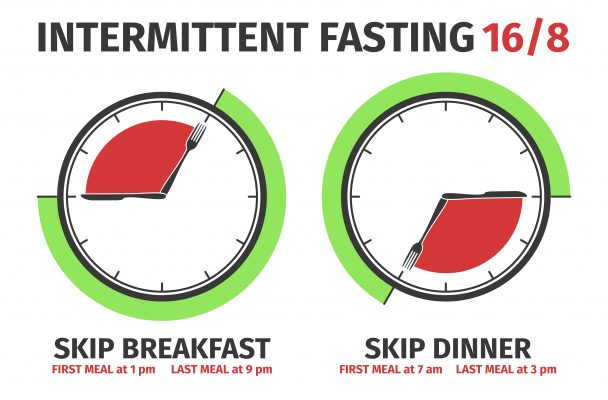Intermittent fasting: a new health approach

One of the most notable forms of intermittent fasting is the 16/8 hour method where you fast for 16 hours then are allowed to eat for 8. Graphic by VectorStock
By George Perkins
Staff Writer
Most Americans agree that we should wake up each morning and eat a hearty breakfast. We should wait until around noon to eat our second meal of the day, before ending our evening with a substantial dinner.
While this dispersed meal plan is perfect for quenching hunger, recent studies like those from Monique Tello at Harvard University, have shown multiple mental and physical health benefits that come from eating less often. Fasting throughout your day until around the late afternoon sounds difficult, and it is, but I would argue that it is worth the effort.
While intermittent fasting seems like a new diet craze or phenomenon that will come and go like all the others, it is not a new concept at all. It is not a diet, either.
Human beings have been fasting for various reasons throughout history. Be it religious, medicinal or for ritualistic purposes, humans have fasted since before Biblical times. Some ancient civilizations would insist on fasting before war. Buddha is said to have fasted for seven weeks.
More importantly, we fast all the time. Every time you go to sleep, your body enters a “fasting state.” Every time you skip breakfast because you are in a rush, you are fasting. Intermittent fasting is quite a simple concept: do not eat for long parts of your day.
While the diet comes in several forms, the most notable is the 16/8 intermittent fast. With this form, you do not eat or drink anything with calories for 16 hours of your day. You also set aside eight hours for meals or your “eating window.” To make it seem less intimidating, remember that at least eight hours should be set aside for sleep.
To put it into perspective, if you stopped eating at 8 p.m. every night, and you are in bed by 11 p.m., only to wake up at 8 a.m., that is a total of nine hours without eating. At this rate, you would only have to fast until 2 p.m. Then, you can eat as you feel fit. This is easier said than done; however, once I saw the true benefits of fasting, it was an easy decision to make the switch.
While most people wanting to make a significant change to their eating habits are looking for an upgrade in their physical health, intermittent fasting also comes with several mental health benefits. Stephanie Bair of the Center of Law and Biosciences at Stanford University states that intermittent fasting increases synaptic plasticity. This has been proven by tests performed on both animals and humans. Our synaptic plasticity is a biological marker of learning and memory.
“[Intermittent fasting] enhances performance on memory tests in the elderly, leads to the growth of new neurons, promotes recovery after stroke or traumatic brain injury, decreases risk for neurodegenerative diseases like Alzheimer’s and Parkinson’s disease and may improve quality of life and cognitive function for those already diagnosed with these diseases,” said Bair.
In other words, it fundamentally upgrades our brains. How does it affect our brains in such drastic ways? When we do not eat for a certain period, we are putting our body through mild stress, similar to exercise. When we do this, it is extremely beneficial for our bodies.
Our cells and biological systems are being challenged, and in turn, they become stronger, more efficient and more capable of handling these stresses. Bair compared it to weight training and how we break down our muscles to further build them back up.
Physically, intermittent fasting can make a difference in not only how we look but how our bodies feel. I lost around 50 pounds while intermittent fasting over the course of about nine months. The main idea of intermittent fasting is that our body uses stored nutrients and energy forms to function, rather than using the nutrients from recently consumed food. This allows us to lose weight while maintaining muscle.
Dr. Mikhail Varshavski says in one of his YouTube videos that there are often misconceptions about intermittent fasting and starvation. Starvation does not take from the stored nutrients in our body. Starvation is, in fact, when we have run out of those stored nutrients, resulting in our body taking from important bodily tissues, like organs, to get the same energy that our body’s stored nutrients would have produced.
Intermittent fasting is not starving yourself. It is simply changing when you start to eat. You will probably see a decrease in caloric intake because you are eating for around eight hours per day instead of 16, but you will still be consuming enough calories to function properly.
For me, intermittent fasting was a life-changing decision. At first, it was quite difficult. I experienced headaches and hunger pains for the first seven to 10 days. After a while, though, it got easier. I no longer had food cravings throughout the day, and my headaches all but disappeared. I began to feel more comfortable with eating a bit less.
I fell into a routine, and my body adjusted to new eating habits. Soon, the results were prevalent. Not only did I start to lose weight, but I also found myself being happier. My grades increased significantly, and I found myself having more energy throughout the day. Obviously, it took more than just intermittent fasting. The food you eat during your “eating window” must be healthy. You should combine intermittent fasting with adequate exercise and sleep habits, as well.
If you are looking for a challenging, yet effective way to change your life for the better, intermittent fasting may be the change you want to make.